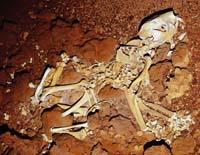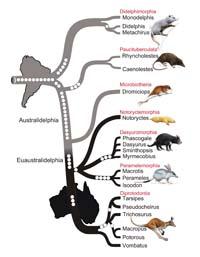Exploring tombs to unravel the Australian mystery
2007/02/23 Galarraga Aiestaran, Ana - Elhuyar Zientzia

In three Australian caves, paleontologists have found a great treasure. (Photo: C. Bryce/Western Australian Museum)
The accumulation of animals in the same cave is unusual, but the geology of the area is singular. Numerous limestone caves are hidden on the banks of the plain. In ancient cycles, the entrances to these caves open and close, and when they are open they are usually a trap for the animals of the area. Thus, many animals have fallen, stacked and fossilized inside the three.
The discovery has allowed researchers to unravel the evolution of Australian fauna. They still don't know why Australian PA disappeared about 45,000 years ago.
Loss of PA

For the first time they find the complete skeleton of a marsupial lion. (Photo: C. Bryce/Western Australian Museum)
Until 50.000-40,000 years ago, in Australia there were many large animals: rhinoceros sized martsupials, 7-metre-long lizards and carnivorous lions living in trees... At that time, however, man arrived on the continent and, with it, these great animals began to disappear. In a few thousand years Australia lost 90% of PA.
But why did they disappear? According to one hypothesis, large animals were not able to cope with climate changes during the glaciation. Specifically, they died as a result of the terrible drought that occurred at that time.
However, analyzing the bones of the animals they have found in the cave, they have come to the conclusion of what they ate and the area in which they lived, and have observed that the area was very dry even at the time when these animals lived. Therefore, it does not seem that climate change is the main cause of its extinction.
Also, not only did the weather change, but the man arrived in Australia. For some paleontologists, the evils caused by men and women were new to wildlife, causing the animals to become ill and die.
Fire and hunting

Computer image of the Martsupial lion (Photo: C. Bryce/Western Australian Museum)
However, for many it is more credible that the hypothesis that the losses were caused by fire and hunting. It seems that in those times there were many fires, some caused by man and others originated naturally. Despite the dry climate, everything was covered with trees, but the fire caused a change of vegetation.
Animals able to eat any plant lasted, but other animals only ate certain plants and without them could not advance. The study of fossils has made it possible to know how the animals of that time had to change the diet, and it is evident that there was an important change. For some too big.
In addition, the man hunted these animals to feed them. Logically, this would also be of little benefit to endangered species. However, it would not be the only reason. Possibly all influenced more or less the climate, fire and hunting.
The fossils they have discovered now have not served to unravel the mystery of the loss of PA. However, the discovery has undoubtedly been important: the three caves have found bones and a mollusk of 68 mammals, birds and reptiles. Among them have been extracted fossils of twenty-three species of kangaroos, eight totally unknown and the complete skeleton of a martsupial lion. In addition, it is believed that there may be more similar graves in the vicinity. So they will continue to look for the treasure.
Published in Deia.

Gai honi buruzko eduki gehiago
Elhuyarrek garatutako teknologia





